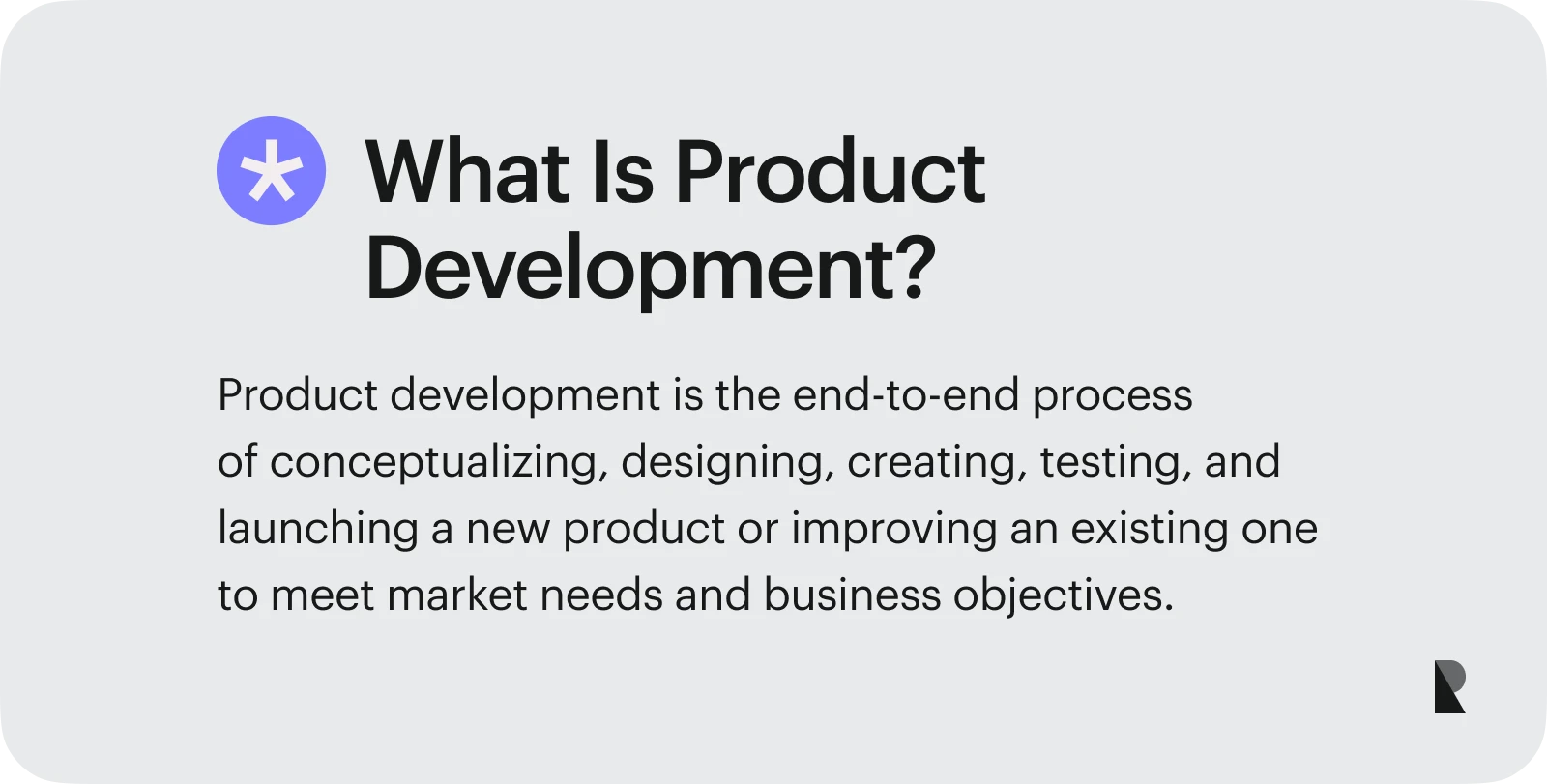
Every product, from the app that tracks your sleep to the cup you drink from each morning, exists because of product development. It’s the process of turning an idea into something people truly value. Product development fuels competitiveness, innovation, and customer satisfaction across every industry.
For design and branding agencies, it’s both art and discipline. It means translating insight into something tangible: guiding idea generation, testing, and product launch in ways that connect emotionally with a target audience while serving real customer needs.
Defining Product Development
Product development is the process of creating a new product or improving an existing product, from concept to market success. It blends imagination with structure, combining business analysis, design, and technology to deliver solutions that meet demand and build loyalty.
Innovation is the ability to “conceive, develop, deliver, and scale new products, services, processes, and business models for customers.” Research actually shows that companies that master innovation generate 2.4 times more profit than those that lag, which is proof that new product development is central to long-term growth.
Understanding the Market and Users
Before any sketch or prototype, market research reveals what people actually want. Interviews, surveys, focus groups, and analytics uncover motivations and frustrations: insights that shape a product’s purpose.
Understanding potential customers reduces risk later in the product development process. It helps teams prioritize features, pricing, and usability with confidence that each choice answers a real-world need within the target market.
Product Development Process: Step by Step
The product development process transforms creative sparks into market-ready results. While methods differ, most successful organizations follow a clear structure that balances vision with validation.

Stage 1: idea generation
Every breakthrough begins with idea generation. Teams draw inspiration from customer feedback, trends, and emerging technology. Creativity meets curiosity here: brainstorming sessions combine data with imagination to surface promising product ideas that reflect both opportunity and feasibility.
Stage 2: idea screening
Once ideas flow, idea screening refines them. The development team assesses feasibility, profitability, and strategic fit. Filtering early keeps resources focused on concepts with the highest chance of becoming viable products and aligns every next step with the brand’s product strategy.
Stage 3: concept development & testing
Concept development turns abstract ideas into visual or functional prototypes. Early UI development or low-fidelity mockups make ideas testable and actionable. Sharing these prototypes with users provides feedback on usability, emotional appeal, and design. Insights from these tests guide whether to advance or adapt the product concept.
Stage 4: marketing trategy and business analysis
Here, creativity meets commerce. Teams define positioning, pricing, and forecast revenue through business analysis. A focused product strategy determines how the new offer competes and connects with its target audience. It aligns designers, marketers, and engineers behind a shared vision of success.
Stage 5: feasibility study and technical design
This is where engineering reality enters. Experts explore resource needs, costs, and technical viability. For digital products, this involves evaluating code quality, frameworks, and performance. Strong collaboration between design and development protects both ambition and efficiency, ensuring that the result feels as good as it functions.
Stage 6: product development and MVP testing
The idea becomes real. Teams build a minimum viable product (MVP), a simplified version that delivers essential value to users. Continuous testing refines performance, accessibility, and customer experience.
Actually, 95% of consumer product executives prioritize launching new products, and 80% plan to increase innovation investment, rising to 85% among profitable companies. Product development is how leading brands maintain relevance and drive growth.
Stage 7: test marketing
Before a full rollout, companies conduct test marketing with limited releases to measure real-world demand. For digital product teams, this could mean A/B testing interfaces or refining onboarding flows. The insights gained here sharpen every element of the coming product launch.
Stage 8: market entry and commercialization
After validation, the new product development process scales. Production expands, logistics synchronize, and marketing campaigns grow louder. A unified product team ensures delivery, branding, and communication feel consistent and credible as the product enters the market.
Stage 9: product launch
The final product reaches its audience through a coordinated launch, storytelling, visuals, and interaction, all of which shape perception. Many brands collaborate with a digital product design agency to refine experience design and presentation, turning anticipation into adoption.
Stage 10: ongoing development and iteration
After launch, development never stops. Feedback, analytics, and evolving technology guide updates and new product ideas. This continuous loop of the product development cycle transforms a one-time release into a living experience that develops in response to its audience.
Building an Effective Product Development Process
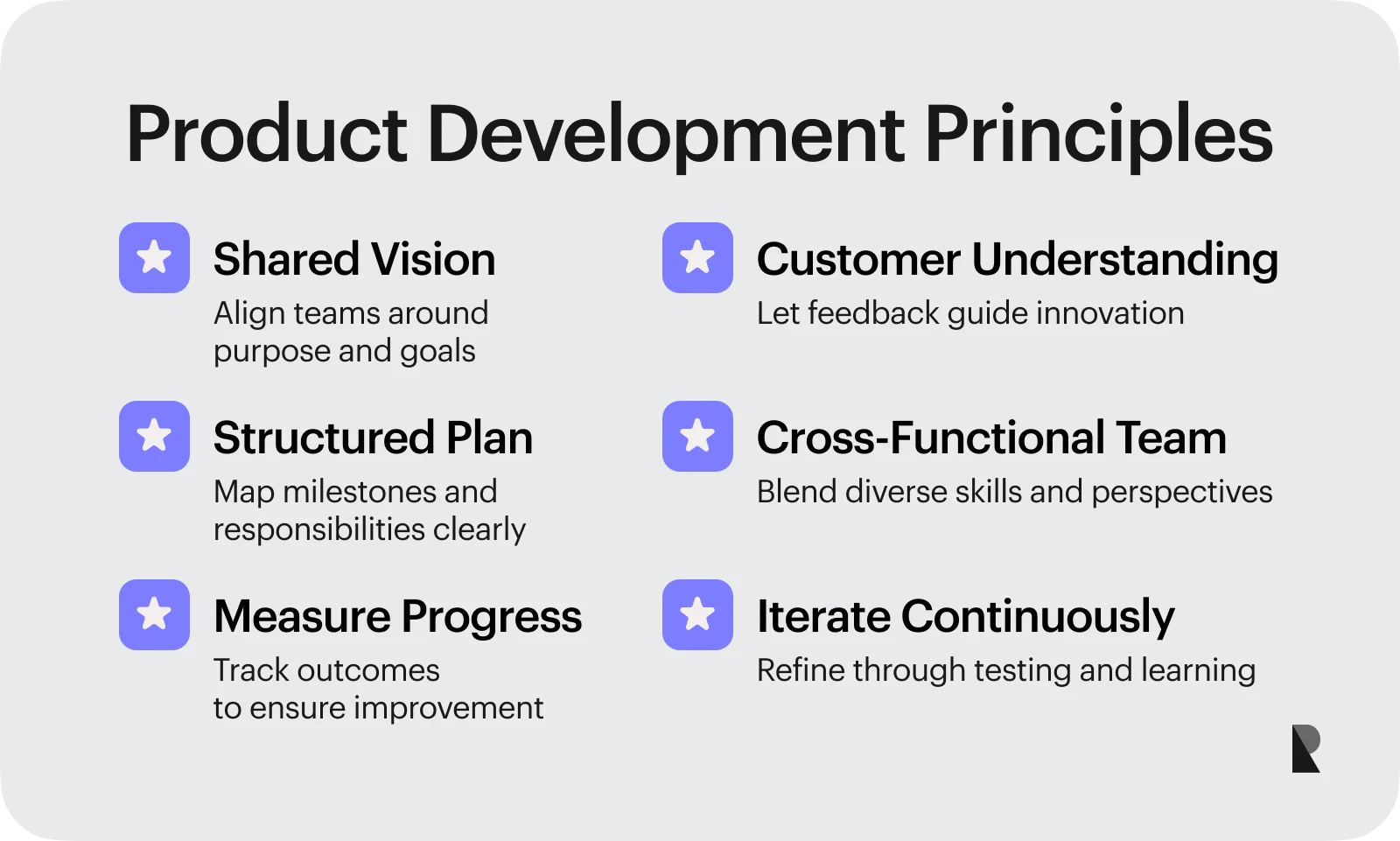
A solid product development process relies on collaboration, insight, and flexibility. The following principles sustain creativity while maintaining progress that is measurable.
Aligning around a shared vision
A clear product vision aligns everyone involved. It defines purpose, direction, and values, providing designers, engineers, and marketers with a shared guiding principle. Unified intent turns complexity into coordinated action.
Understanding customer needs
Empathy drives innovation. Continuous feedback loops reveal evolving customer needs and spark improvement. Teams that stay close to their users create new products that feel intuitive and essential rather than experimental.
Building a strong cross-functional team
Great products come from diverse minds. A product team combines strategists, developers, and designers who collaborate across stages of development. Designers shape usability and visual hierarchy, developers maintain code quality, and marketers communicate relevance. Cross-functional trust keeps creativity productive.
Creating a product development plan
Finally, structure supports imagination. A defined product development plan maps milestones, resources, and ownership. It provides product management with the clarity to coordinate and adapt, striking a balance between ambition and accountability as development unfolds.
Product Development Frameworks and Best Practices
A well-structured product development process is only as strong as the frameworks guiding it. These frameworks help teams transform creative uncertainty into structured exploration, ensuring innovation remains consistent, measurable, and user-centered.
Popular frameworks
Different teams employ various approaches to transition from concept to final product, but the most proven methods share a common goal: learning quickly while minimizing waste.
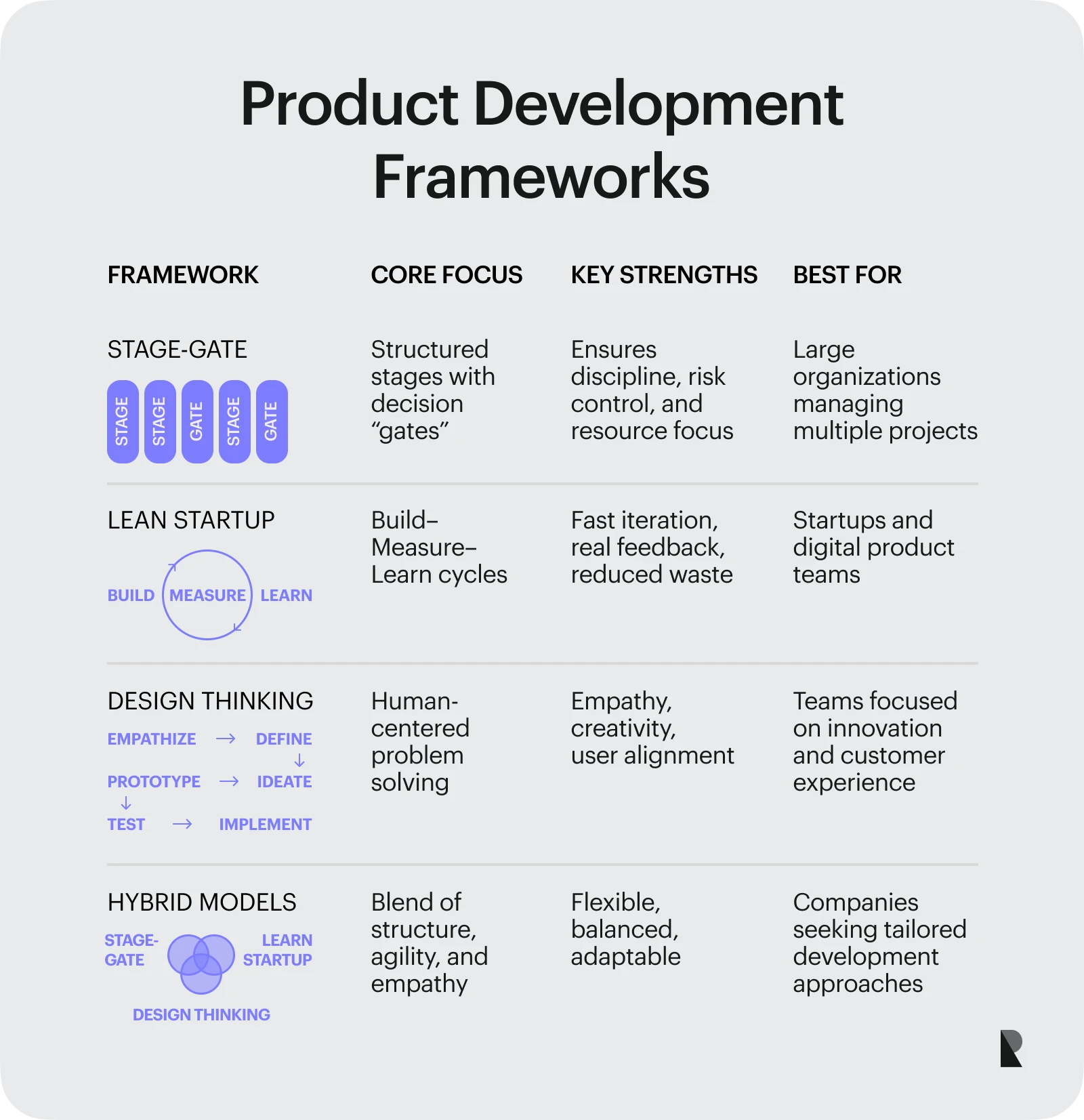
Stage-gate divides new product development into a series of stages separated by “gates.” Each gate requires evaluation before moving forward, ensuring decisions are deliberate and resources stay focused. It works exceptionally well for large organizations managing multiple concurrent projects.
The Lean startup approach takes a different approach. It prioritizes speed, experimentation, and constant iteration. Teams build, measure, and learn in cycles using real-world feedback to refine ideas before full production. For digital products, this often means launching MVPs, gathering user data, and adjusting design or code quality in response.
Design thinking merges creativity with empathy. It centers on human needs, encouraging teams to deeply understand users before defining, prototyping, and testing solutions. This framework bridges the gap between design and engineering, between imagination and implementation, and is particularly valuable to product teams within agencies that focus on interaction design and customer experience.
Many companies adopt a hybrid model, blending the discipline of Stage-Gate with the adaptability of Lean and the empathy of Design Thinking. The right mix depends on the team’s maturity, goals, and the type of new product being developed.
Tips for Stronger Product Development

Beyond structure, the mindset of product development determines its success. The following principles distinguish great development teams from merely good ones.
1. Prioritize iteration
Innovation happens through minor, repeated improvements. Each test, from early wireframes to test marketing pilots, builds confidence and uncovers new insights. Iteration turns uncertainty into progress, helping products mature gracefully.
2. Stay user-focused
The most sophisticated process can still fail without empathy. Constantly revisiting user research and customer needs prevents feature overload and keeps development purposeful. Honest feedback should guide not only what’s built but also what’s left out.
3. Communicate clearly and often
Alignment across teams prevents friction. Designers, engineers, and marketers must share vocabulary and priorities, especially when defining a product strategy. Open communication fosters trust, accelerates iteration, and keeps creativity grounded in a shared intent.
4. Embrace data and emotion equally
Great products live at the intersection of analytics and feeling. Numbers reveal behavior; design evokes meaning. When graphic design, visual hierarchy, and storytelling support the data, users feel both understood and inspired.
5. Design for longevity
The development process doesn’t end at launch. Ongoing iteration, updates, and performance reviews maintain relevance. A brand that continuously adapts builds credibility and turns customers into advocates.
Real-World Examples of Good Product Development
To understand how these principles work in practice, let’s look at three real-world examples. Each shows how insight, iteration, and a strong product team can redefine industries.
Netflix: innovating through experimentation
Netflix exemplifies continuous development. From its early DVD model to its current streaming and global content production, every decision has been driven by data and user behavior.
Behind each interface change lies relentless testing. Netflix frequently experiments with various layouts, recommendations, and visuals tailored to specific audiences, tracking engagement and conversions in real-time. This method embodies the new product development process: launch, measure, refine.
By focusing on personalization and predictive algorithms, Netflix built a customer experience that feels tailored to each viewer. Its success illustrates that product development isn’t a one-time act; it’s a constant dialogue with users, fueled by insights and iteration.
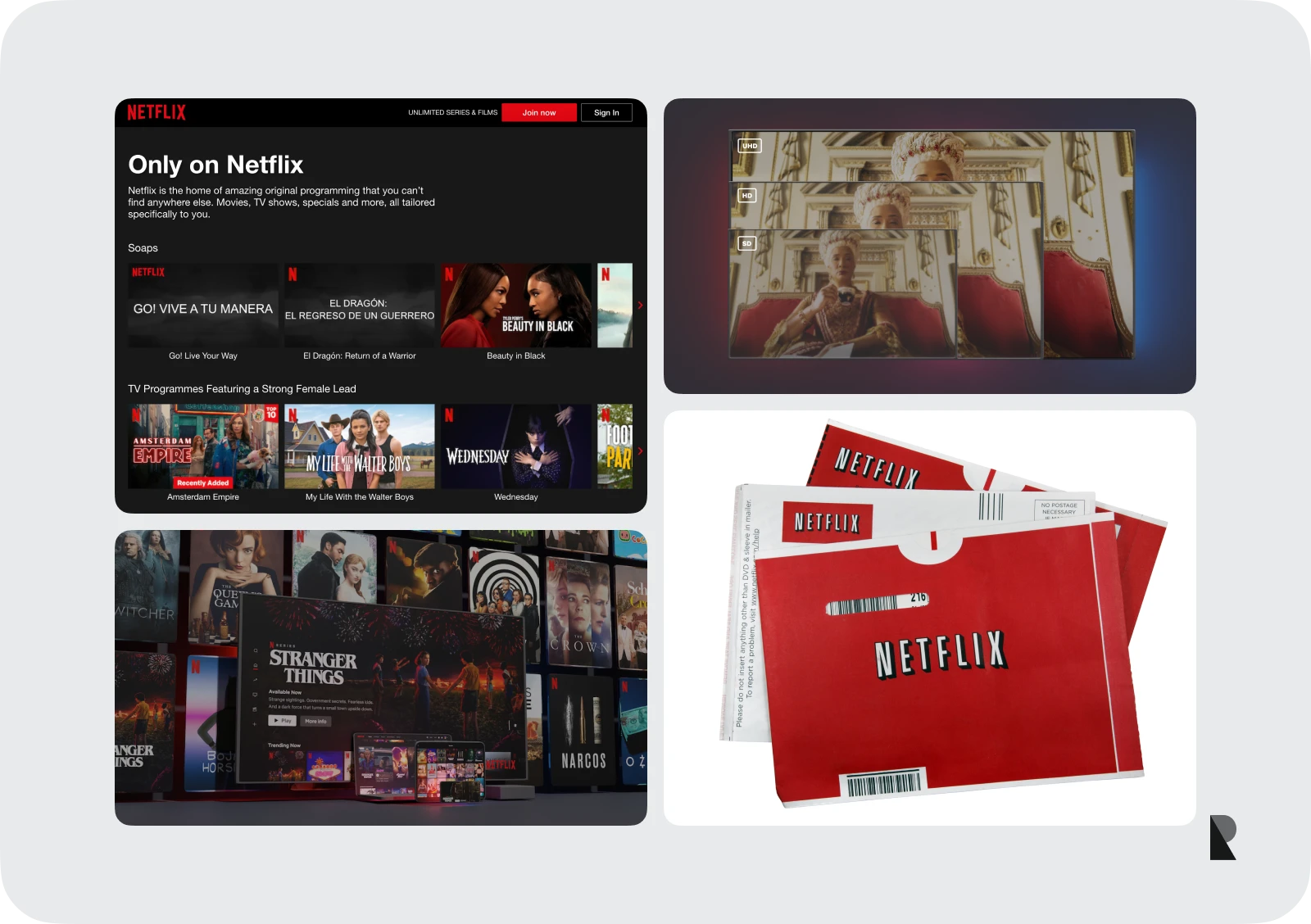
Uber: rapid scaling and adaptive strategy
Uber’s growth shows the power of an agile development team working at speed. In its early years, Uber combined idea generation with real-world testing across pilot cities. Each launch served as test marketing, revealing how local regulations, pricing, and behavior varied by region.
The company’s product strategy evolved as it expanded. By adjusting features from ride tracking to payment options, it has transformed from a luxury car service into a global mobility platform.
Its new product development model remains iterative: test locally, learn quickly, scale globally. The adaptability of its product teams enabled Uber to innovate faster than its competitors while maintaining a focus on reliability and simplicity.
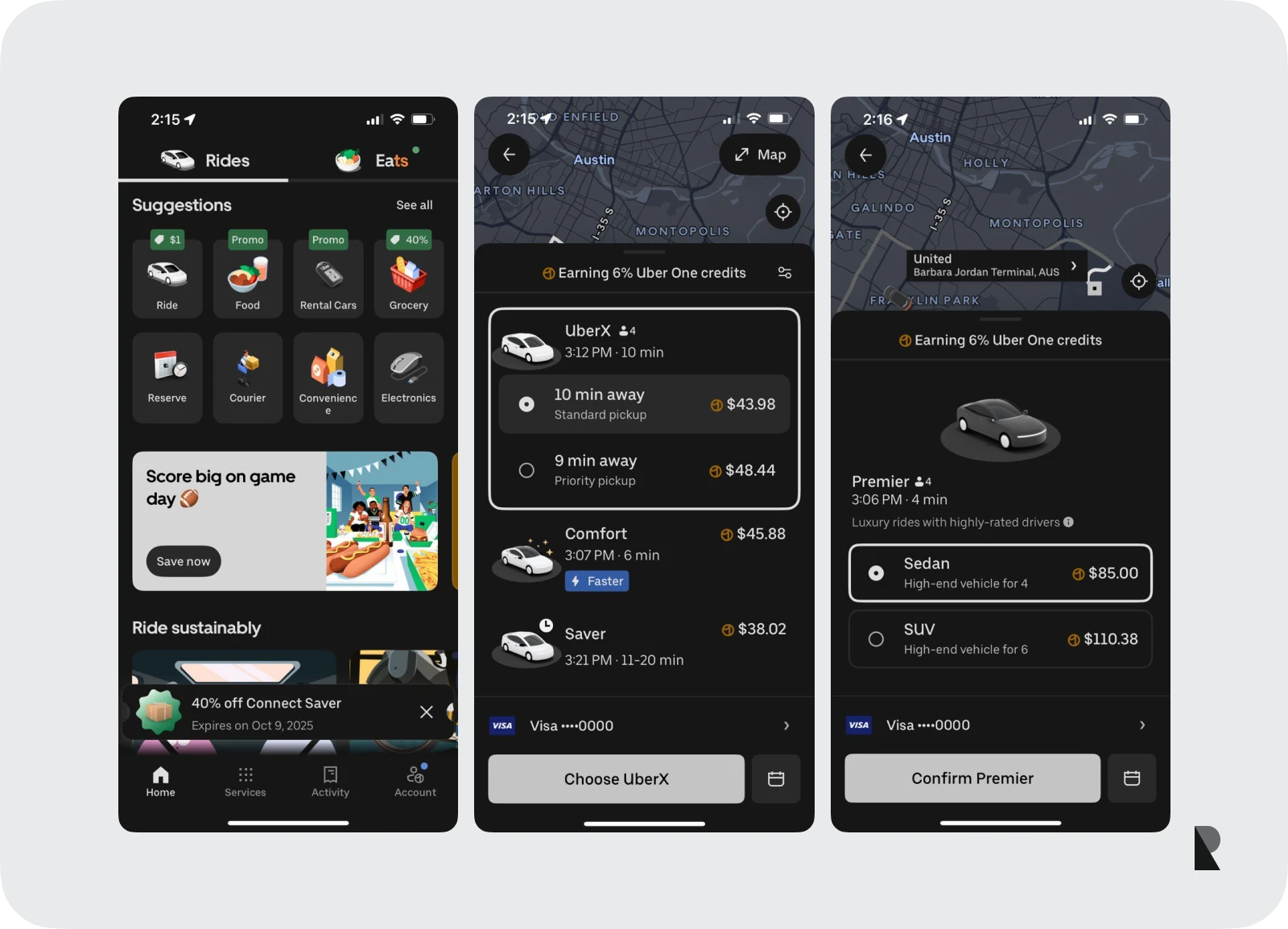
Roomba: from concept to category leader
When iRobot introduced the Roomba, few consumers imagined that autonomous cleaning devices would become household staples. The brand’s concept development process paired robotics research with deep market research into consumer habits.
Early prototypes emphasized simplicity and trust as key emotional barriers for a product that moved independently in people’s homes. Through multiple rounds of feedback, testing, and product development, iRobot refined usability and pricing to reach mass appeal.
The Roomba’s success demonstrates that technology alone isn’t innovation. It’s the connection between human behavior, emotional reassurance, and functionality that makes a new product thrive.
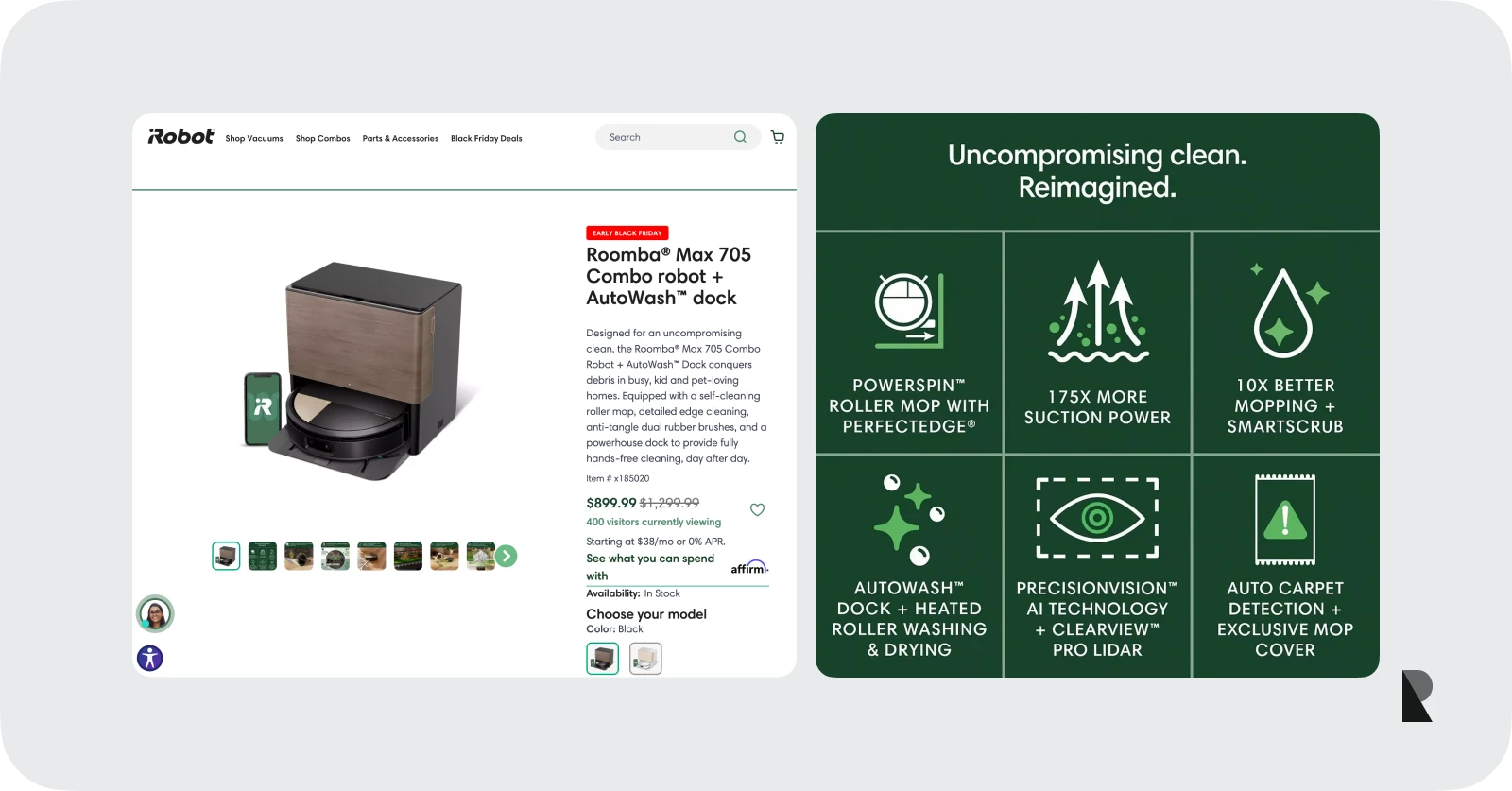
Why Frameworks and Examples Matter
These examples show that significant product development is less about luck and more about discipline. Each company built its advantage by combining structure with empathy, using data to guide decisions while staying attuned to what customers truly feel.
Whether building software or physical goods, the balance between design, engineering, and research defines the result. The same principles apply across sectors: collaboration, experimentation, and focus on the human outcome.
For agencies, studying these frameworks helps refine their approach to client work. It reinforces that brand-led product development doesn’t just create tools, it builds trust.
How Design Strengthens Product Development
Design is the bridge between what users need and what businesses deliver. It turns abstract strategy into tangible experience. A strong visual system, rooted in graphic design principles such as emphasis, repetition, and visual hierarchy, guides attention and emotion. These fundamentals don’t just make interfaces appealing; they make them usable and memorable.
In digital product environments, design also shapes interaction. Understanding UX history and interaction design principles helps ensure continuity between brand, product, and behavior. Great design clarifies purpose and builds consistency across every touchpoint.
This is why many companies collaborate with a digital product design agency. Such partnerships fuse brand identity with user experience, aligning creativity with measurable results. They help translate conceptual innovation into products people love to use and remember.
The Role of Strategy in Product Development
Behind every successful launch lies an intentional strategy. It defines why a product exists, how it competes, and what value it creates. A strong product strategy starts with the user but extends to business outcomes. It connects opportunity to capability, identifying how resources, technology, and market timing intersect to create effective solutions.
Agile strategy also means knowing when to pivot. Not every idea becomes a success, but each stage of development offers valuable lessons. Teams that learn fast build resilience, turning missed opportunities into insights for the next iteration.
By embedding strategies within the new product development process, brands turn creativity into sustainable performance, aligning the speed of innovation with the steadiness of purpose.
Conclusion
Product development is more than production; it’s a reflection of how organizations think, collaborate, and adapt. From idea screening to commercialization, each step blends creativity, data, and empathy. Companies that invest in structured yet flexible development processes gain a lasting edge. They align teams under a unified product vision, listen to users, and continually refine their approach long after launch.
The most successful products don’t just fill gaps in the market; they also create new opportunities. They shape expectations, strengthen brand identity, and create emotional connections that last. Whether through digital product design or physical innovation, the principle remains the same: products that evolve with their customers win. If you’re looking to master this process, too, checking out top user experience design companies might be a good way to start.
Oct 31, 2025
